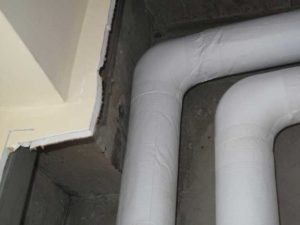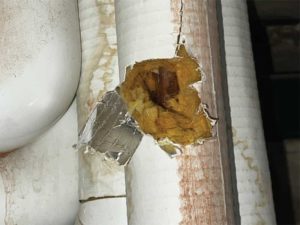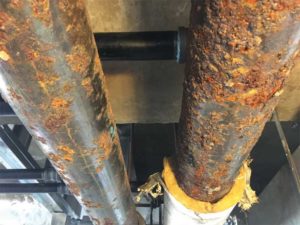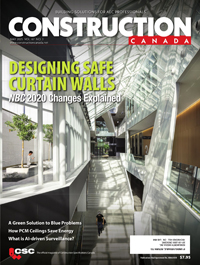Failures in plumbing pipe due to construction methods

The pitched pipe was incorrectly adjusted to install a nitrogen charging unit into the system. Nitrogen purges oxygen from pipes, thus preventing further corrosion. This is an instance of a contractor unknowingly affecting the performance of a system installed by another contractor with what appeared to be minor adjustments. Best practice is to make a final check of the sprinkler system after all components in the space are installed. It is also important for an engineer be involved at all stages of design and renovation.
Steel pipe in chilled water applications is susceptible to corrosion from surface condensation in a humid environment. Pipe insulation is used on chilled water pipe to minimize thermal transfer between the pipe and the ambient environment, and to inhibit condensation of water vapour on the pipe surface that can lead to accelerated corrosion of steel pipe—a mechanism known as corrosion under insulation (CUI).

To prevent CUI, pipe insulation is installed with a moisture retarding cover, and insulation joints and seams must be carefully sealed with approved tape to form a competent vapour barrier that inhibits the intrusion of moisture-laden air to the pipe surface. Correctly installed insulation with an intact vapour barrier will protect chilled water pipe from CUI for many years of service (See image 8). Unfortunately, in their inspection of plumbing systems, the authors’ company frequently encounters pipe where the insulation vapour barrier has been compromised due to poor installation or damage from adjacent construction (See image 9), resulting in failures from CUI (See image 10).
Since plumbing pipe and other utilities are often installed in tight spaces, inadvertent damage during construction or renovations can occur. It is important that, when all construction is complete, insulated plumbing pipe is inspected to ensure the integrity of the insulation vapour barrier has not been compromised.

Conclusion
Properly designed and installed plumbing pipe should not experience significant corrosion for the anticipated service life of the system. However, actions during the construction or renovation of a building can alter the environment of these systems, resulting in unanticipated and costly corrosion problems. Any construction activities that could impact a plumbing system should be properly assessed to preclude premature corrosion failure.
Notes
1 Refer to the Canadian Copper & Brass Development Association, visit http://en.coppercanada.ca/videos-publications/publications/pub28/pub28e-section1.html
2 See note 1.
Authors
 lan Humphreys is a staff consultant and metallurgist in the engineering mechanics and infrastructure group at Simpson Gumpertz & Heger. He specializes in the failure analysis and structural assessment of materials systems which have degraded by mechanisms such as corrosion, fracture/fatigue, or wear. Humphreys can be reached at aohumphreys@sgh.com.
lan Humphreys is a staff consultant and metallurgist in the engineering mechanics and infrastructure group at Simpson Gumpertz & Heger. He specializes in the failure analysis and structural assessment of materials systems which have degraded by mechanisms such as corrosion, fracture/fatigue, or wear. Humphreys can be reached at aohumphreys@sgh.com.
 Phillip Sharff is a principal at Simpson Gumpertz & Heger. He specializes in the performance of underground structures, piping systems, building and mechanical components, industrial structures, tanks, and structural materials. He has led many failure investigations of buried structures, building components, piping, and structural plastics materials, often involving forensic field studies, laboratory testing programs, structural analysis, and expert testimony. Sharff can be reached at pasharff@sgh.com.
Phillip Sharff is a principal at Simpson Gumpertz & Heger. He specializes in the performance of underground structures, piping systems, building and mechanical components, industrial structures, tanks, and structural materials. He has led many failure investigations of buried structures, building components, piping, and structural plastics materials, often involving forensic field studies, laboratory testing programs, structural analysis, and expert testimony. Sharff can be reached at pasharff@sgh.com.







